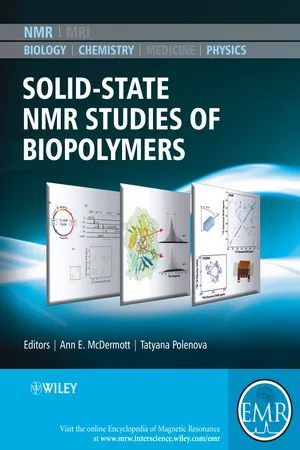![]()
PART B
Recent Developments in Solid-State NMR Hardware and Emerging Methodologies for Structural and Dynamics Studies of Biopolymers
![]()
Chapter 8
Probe Development for Biosolids NMR Spectroscopy
Peter L. Gor’kov1, William W. Brey1 and Joanna R. Long2
1National High Magnetic Field Laboratory, Florida State University, Building 232, 1800 E. Paul Dirac Drive, Tallahassee, FL, 32310, USA
2Department of Biochemistry and Molecular Biology, University of Florida, Gainesville, FL, 32611, USA
8.1 Introduction
The potential of solid-state NMR (SSNMR) spectroscopy as a tool for investigating complicated biological problems has long been appreciated. The spectroscopic selectivity possible with biosolids NMR is unique in answering mechanistic questions, allowing one to measure in situ the structure and dynamics of specific sites in insoluble biomolecular complexes at atomic resolution. It has also shown promise in recent years for solving complete structures of certain proteins that are not amenable to more conventional techniques due to insolubility or due to insufficient crystallization domains. In particular, structures for proteins crystallized on the nanometer scale or reconstituted into lipid bilayers are now available in the protein data bank.
Much of the recent progress in applying SS-NMR spectroscopy to biomolecular systems is due to technical advances in NMR experiments, including the development of pulse sequences for addressing specific interactions, improved signal-to-noise (S/N) through the design of higher field magnets, and the development of signal detection technology. In addition, advances in protein expression, isotopic labeling strategies, sample preparation methodologies, and mechanical manipulation of samples have increased sample availability, resolution, selectivity, and sensitivity.
The major challenge and benefit of examining biomolecular complexes in the solid state is that the spatial components of the NMR interactions are no longer fully averaged by isotropic tumbling of the molecules on the NMR timescale. These interactions contain valuable information about the structure, dynamics, and organization of the system of interest, but they also lead to broad featureless spectra when examined by standard high-resolution NMR spectroscopy. In order to gain resolution and enhance sensitivity, it is necessary to remove or reduce the anisotropic interactions by either applying strong and precisely controlled radiofrequency (RF) fields, orienting the molecules relative to the external magnetic field, mechanically rotating the sample about an angle (the “magic” angle), or a combination of these techniques. However, by proper selection of sample conditions and pulse experiments, one can obtain high-resolution spectra and measure the structure and dynamics of the molecules in complex samples at atomic resolution.
The requirements for spin choreography via RF control and mechanical sample manipulation present unique design considerations in terms of biosolids’ NMR probe construction and optimization. For biomolecular samples, these include trade-offs between maximum achievable RF fields, RF field homogeneity, optimal S/N, and sample geometry. In addition, the thermal limitations of many biomolecular samples require contemplation of the relationship between B-fields and E-fields for a chosen RF coil geometry. These issues become more salient at high magnetic fields due to more rigorous bandwidth requirements, as chemical shift anisotropies scale with magnetic field, and due to increased risk of sample heating during the application of RF pulses at higher frequencies.
8.2 GENERAL CONSIDERATIONS
8.2.1 Maximizing Sensitivity
Nuclear spin transitions generally occur in the 10–1000-MHz range with currently available high-field commercial magnets. The low irradiation energies allow one to interrogate molecular structure and dynamics without destroying delicate samples, but they also limit the inherent sensitivity of NMR spectroscopy due to Boltzmann statistics. NMR signals are typically transmitted and received via coaxial cable to a copper coil, tuned to the proper frequency, surrounding the sample in the NMR magnet. For biomolecular samples, multiple frequencies, corresponding to the nuclei of interest, are utilized for decoupling and recoupling of the nuclear spins. In particular, 1H decoupling is critical in removing heteronuclear dipolar couplings and allows the detection of high-resolution spectra for 13C and 15N nuclei. Signal acquisition is typically via observation of the lower γ nuclei because strong homonuclear 1H dipolar couplings broaden the proton signals, although significant strides in 1H-detected SSNMR spectroscopy have been made.1–6
The receiver noise figure of commercially available NMR spectrometers is typically less than 1.5 dB over the range of frequencies used for NMR detection, and so affords nearly full S/N. The primary sources of noise arise within the NMR probe and the sample.7–10 At lower reception frequencies, and for smaller and less conductive samples, m...
